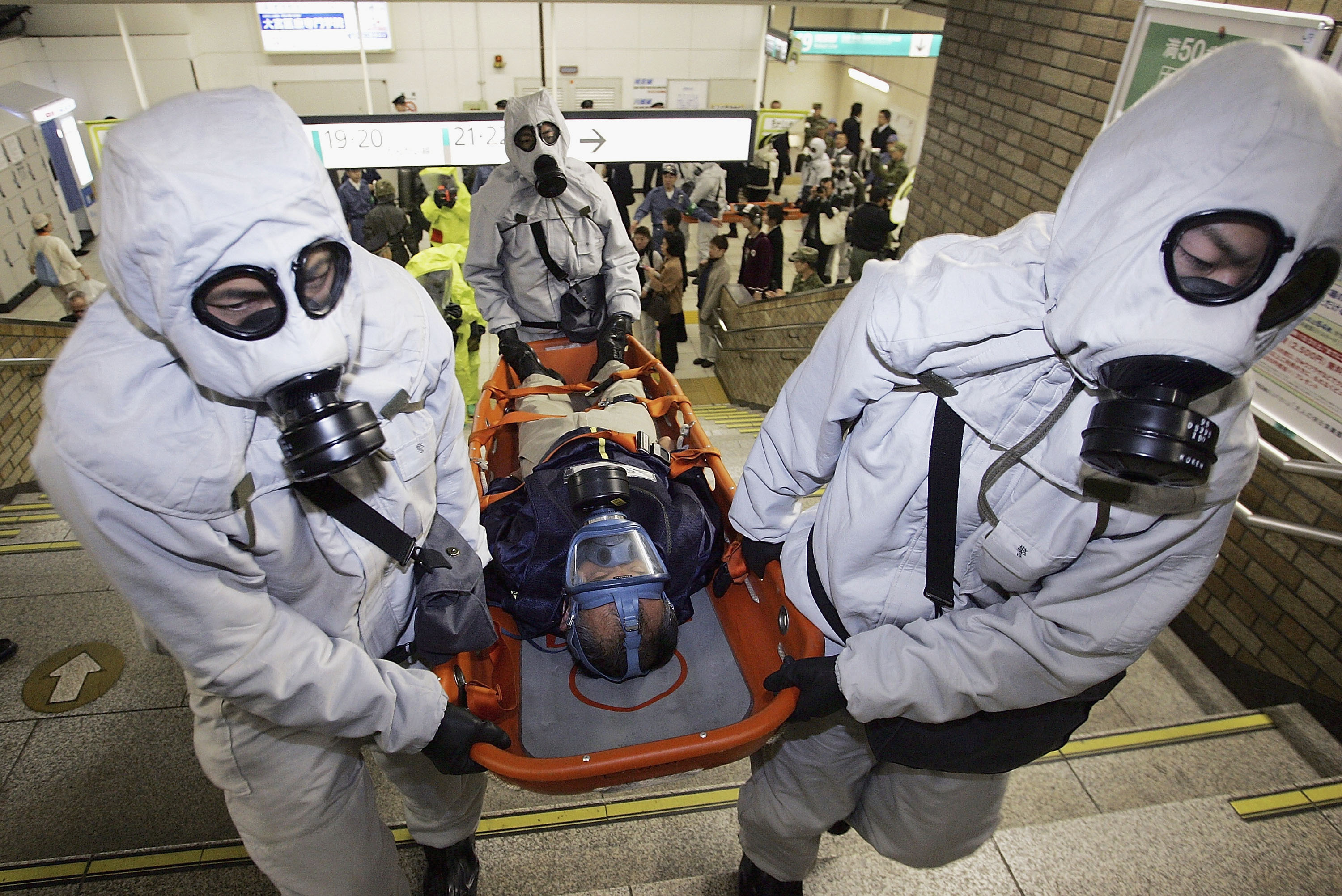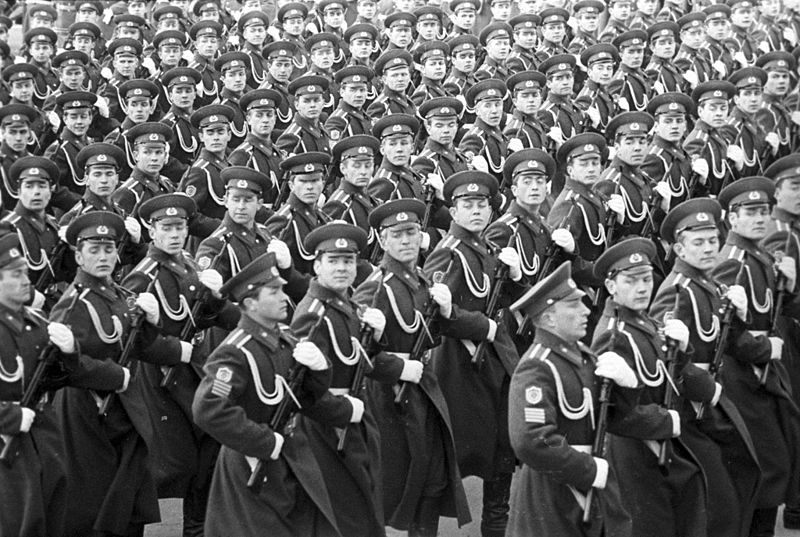The Surprising, Sordid Story of Sarin, Syria's Alleged Chemical Weapon
Nazi war criminals, US oil companies, test rabbits: the sordid story of Sarin
August 29, 2013— -- The United States and its allies moved fast in recent days to confirm that Syrian ruler Bashar al-Assad used chemical weapons on his own citizens as part of a civil war offensive that's killed an estimated 100,000 people.
Recent reports suggest Assad attacked civilians with Sarin, a deadly nerve agent that's been renounced by the international community.
While it's still unclear what future consequences Assad will face for the attacks, his weapon of choice has a vividly colored past. From Hitler's arsenal to Uncle Sam's stockpile, here's a look at the history of Sarin, one of the world's most feared chemical killers.
(Much of this information comes from the 2006 book "War of Nerves: Chemical Warfare From World War I to Al-Qaeda," by the late biochem weapons expert Jonathan B. Tucker. For more info, check the book out online.)
1: WHAT SARIN IS Sarin is an odorless, colorless nerve agent that kills humans by overstimulating the nerves in their muscles. When exposed to Sarin as a liquid or vapor, a person's muscles fail to "switch off," causing convulsions, vomiting and drooling, paralysis, and death by asphyxiation.
Sarin is an odorless, colorless nerve agent that kills humans by overstimulating the nerves in their muscles. When exposed to Sarin as a liquid or vapor, a person's muscles fail to "switch off," causing convulsions, vomiting and drooling, paralysis, and death by asphyxiation.
Also called GB, the nerve agent was declared a "weapon of mass destruction" by the United Nations in 1991, and its production and stockpiling were banned by the international Chemical Weapons Convention two years later. (Photo: Getty Images)
2: WHAT MAKES SARIN SPECIAL There are many different nerve agents, but Sarin has long been preferred for its lethality. While extremely dangerous to produce, it can be replicated relatively cheaply, which is one reason small rogue states and terrorists have worked on stockpiling it.
There are many different nerve agents, but Sarin has long been preferred for its lethality. While extremely dangerous to produce, it can be replicated relatively cheaply, which is one reason small rogue states and terrorists have worked on stockpiling it.
The Japanese terrorist cult Aum Shinrikyo produced its own Sarin in a $10 million dollar facility in the 1990s, using the agent in its gaseous form to kill 13 people on the Tokyo subway in 1995. Saddam Hussein was known to have used Sarin on Iranian soldiers and Iraqi Kurds before the first Gulf War.
Bashar al-Assad, Syria's dictator, is known to have stockpiled Sarin previously, which is one reason it's the primary focus in the Syria chemical attacks. (Photo: Getty Images)
3: WHERE IT CAME FROM German chemists "discovered" the nerve agent, then called "Substance 146," in 1938 while doing pesticide research. (That's its molecular composition shown above.) It was named "Sarin" after the four researchers who developed it: Schrader, Ambros, Rüdiger and Van der Linde. (Photo: Amir.ahrls/Wikimedia Commons)
German chemists "discovered" the nerve agent, then called "Substance 146," in 1938 while doing pesticide research. (That's its molecular composition shown above.) It was named "Sarin" after the four researchers who developed it: Schrader, Ambros, Rüdiger and Van der Linde. (Photo: Amir.ahrls/Wikimedia Commons)
4: SARIN'S CO-INVENTOR: NAZI WAR CRIMINAL One of those inventors, Otto Ambros, became Hitler's chief chemical weapons engineer and put Sarin into production for the Nazi war effort. Ambros (shown standing above) also oversaw the production of a government rubber plant at the Auschwitz concentration camp, using Jewish prisoners as labor. Many of the workers died on the job or were later put to death.
One of those inventors, Otto Ambros, became Hitler's chief chemical weapons engineer and put Sarin into production for the Nazi war effort. Ambros (shown standing above) also oversaw the production of a government rubber plant at the Auschwitz concentration camp, using Jewish prisoners as labor. Many of the workers died on the job or were later put to death.
In 1948, he was convicted of war crimes and crimes against humanity at Nuremburg and sentenced to eight years in prison. One prosecutor, disgusted by the light sentence, wrote a book about Ambros and his colleagues titled "The Devil's Chemists." (Photo: Keystone/Hulton Archive/Getty Images)
5: EX-NAZI AIDS THE AMERICAN ARMY Ambros only served half of his prison sentence. After his release in 1951, he was whisked to the West to advise the U.S. Army on its own chemical weapons program -- including Sarin.
Ambros only served half of his prison sentence. After his release in 1951, he was whisked to the West to advise the U.S. Army on its own chemical weapons program -- including Sarin.
Before his death, Ambros also worked with Dow Chemical, and he advised a pharmaceutical company that marketed thalidomide, the infamous birth-defect-causing drug, to pregnant women. (Photo: U.S. Army)
6: A SARIN-BASED ARMS RACE After World War II, American military leaders went on a PR offensive, arguing that the U.S. needed to develop Sarin and other nerve agents to deter the Soviets from attacking first with their own chemical weapons.
After World War II, American military leaders went on a PR offensive, arguing that the U.S. needed to develop Sarin and other nerve agents to deter the Soviets from attacking first with their own chemical weapons.
"At this time," one U.S. general said, "the only safe course is to be prepared to defend ourselves and ready to use gas in overpowering quantities." (Photo: RIA Novosti/Wikimedia Commons)
7: SHELL OIL GETS INTO THE SARIN BUSINESS In the early 1950's, the U.S. began producing Sarin for use in artillery shells and rockets. For a time, it partnered with Shell, the gas company, to manufacture and stockpile the weapons at the Army's Rocky Mountain Arsenal in Colorado.
In the early 1950's, the U.S. began producing Sarin for use in artillery shells and rockets. For a time, it partnered with Shell, the gas company, to manufacture and stockpile the weapons at the Army's Rocky Mountain Arsenal in Colorado.
(Those weapons include the "Honest John" warhead shown above, containing dozens of bomblets that each contained about a pound of Sarin.)
"Shell produced dichlor for the Army," according to an official military historical account. "The Army used dichlor in an intermediate process in the manufacture of GB nerve agent." (Photo: US Army/Wikimedia Commons)
8: SARIN, AN ENVIRONMENTAL DISASTER In addition to nerve weapons components, Shell produced 18 insecticides & herbicides at the Rocky Mountain Arsenal. "Aldrin, dieldrin, and endrin were produced by Shell" on the Army base "and successfully marketed worldwide until their use was banned in 1974."
In addition to nerve weapons components, Shell produced 18 insecticides & herbicides at the Rocky Mountain Arsenal. "Aldrin, dieldrin, and endrin were produced by Shell" on the Army base "and successfully marketed worldwide until their use was banned in 1974."
Production of Sarin and these other compounds was dangerous and created many toxic waste byproducts, which the military and its contractors dumped carelessly. (Authorities used test rabbits, like the one shown above, to check for deadly vapor leaks on the base.)
According to an investigation by Colorado authorities, "From 1942 until 1982, activities of the Army and Shell at the Arsenal resulted in the release of at least 176,000 tons of hazardous substances into the environment." (Photo: Wikimedia Commons)
9: VITRO CORP, THE ARMY'S LEAKY SARIN PARTNER The Army's main corporate partner in Sarin production, however, was a contractor called the Vitro Corporation, which produced the chemical at a leak-prone plant in northwestern Alabama. The deadly concoction was transported to Rocky Mountain Arsenal in special nickel-plated railroad cars.
The Army's main corporate partner in Sarin production, however, was a contractor called the Vitro Corporation, which produced the chemical at a leak-prone plant in northwestern Alabama. The deadly concoction was transported to Rocky Mountain Arsenal in special nickel-plated railroad cars.
After a series of acquisitions and bankruptcies, Vitro merged with British Aerospace to create BAE Systems, one of the largest defense contractors in the world. (Photo: National Archives/Wikimedia Commons)
10: THE SARIN-INDUSTRIAL COMPLEX COMES FULL-CIRCLE BAE now helps produce most of the U.K.'s military ships and submarines and many of its aircraft, such as the Harrier fighter jet. BAE also supplies many of the U.S.'s land and naval guns, as well as systems on many of its fighter planes.
BAE now helps produce most of the U.K.'s military ships and submarines and many of its aircraft, such as the Harrier fighter jet. BAE also supplies many of the U.S.'s land and naval guns, as well as systems on many of its fighter planes.
This means that if the U.S. and U.K. launch a military offensive against Syria, they will use BAE-supplied ships and aircraft to punish the Syrian regime for using Sarin nerve weapons, which a BAE subsidiary once perfected for the US military's use decades ago. (Photo: Royal Navy/Wikimedia Commons)